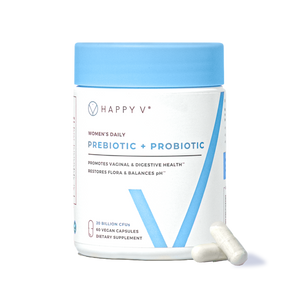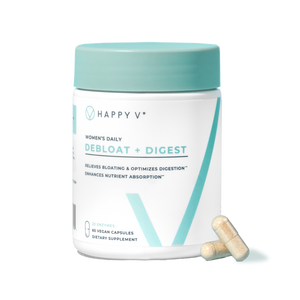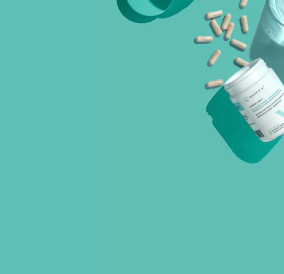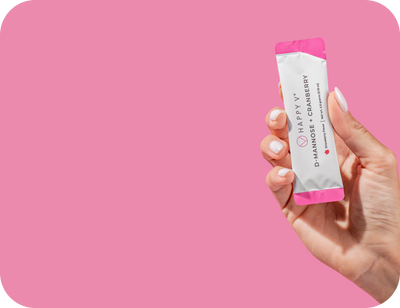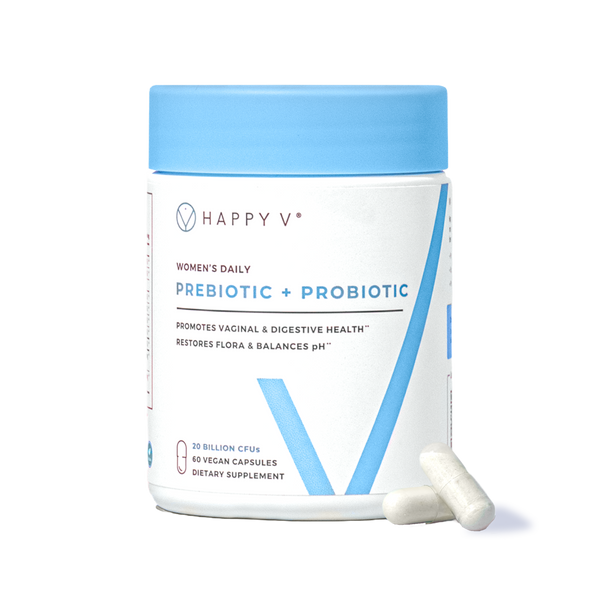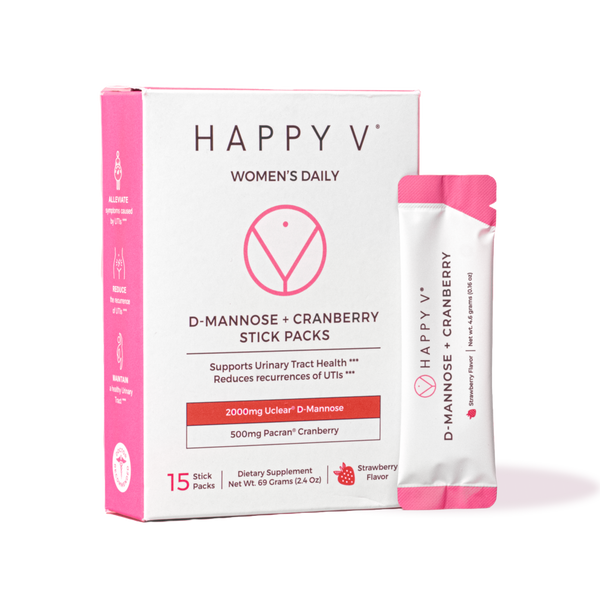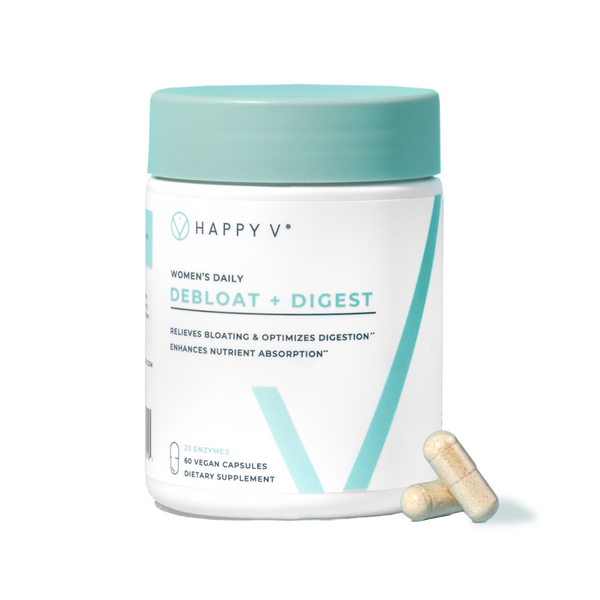- Fact Checked
- October 02, 2025
- 13 min read
How to Reduce PMS Symptoms Naturally
Table of Contents
Table of Contents
Though few people look forward to their “time of the month,” for women with premenstrual syndrome (PMS), their period can cause huge disruptions to their daily life, with physical and psychological symptoms that feel totally out of their control.
The good news is that even many of the most disruptive and scary symptoms of PMS (think: uncontrollable mood swings, anxiety attacks, and low energy levels) can often be managed naturally. While these evidence-based home remedies may not make PMS symptoms disappear completely, many women find they make them far less severe and allow them to keep living life as normal, even while on their period.
This post is for informational purposes only and does not constitute medical advice. See full disclaimer below.
What Is PMS?
Before we dive into how to effectively manage and mitigate PMS symptoms, it’s helpful to understand what PMS even is.
PMS, or premenstrual syndrome, refers to the series of symptoms that occur around the time of menstruation1. These symptoms typically begin about a week before menstruation and last several days into the period (although, as with anything health-related, this varies from person to person).
PMS is remarkably common. As many as 80 to 90% of women report some form of PMS symptoms around their period, with the most common being mild cramping. Other common symptoms of PMS include:
- The tendency to cry easily (affects approximately 31.8% of women)
- Depressed mood (affects approximately 53% of women)
- Anxiety and irritability (affects approximately 51% of women)
In fact, there are over 100 symptoms associated with PMS, ranging from insomnia to bloating to headaches, cravings, constipation, and changes in sex drive.
For the majority, these symptoms are mild, but as many as 25% of women report that these symptoms are moderate to severe.
What Causes PMS?
No one knows exactly what causes PMS. In fact, there might not be any one thing that causes PMS, but a variety of things, including:
Hormonal fluctuations
Your levels of estrogen and progesterone naturally fluctuate throughout your menstrual cycle, but particularly after ovulation, which is when many women experience PMS symptoms2.
Neurotransmitter imbalances
Fluctuations in serotonin and other brain chemicals can influence mood, appetite, and sleep, all of which can contribute to the emotional and psychological symptoms of PMS3.
Stress management
High stress doesn’t directly cause PMS, but it can make symptoms feel more intense and harder to cope with during the premenstrual phase4.
Genes
As with so many aspects of women’s health, your genetic makeup may increase your susceptibility to PMS. If your mother or sisters experience PMS, you are more likely to as well.
Environmental factors
Lifestyle and environmental influences, such as diet, exercise, and sleep habits, may affect how strongly PMS shows up each month.
PMS vs. PMDD
For a small but significant percentage of women (around 5%), PMS symptoms are so severe they actually transition from being PMS to PMDD, or premenstrual dysphoric disorder. PMDD is essentially a more severe form of PMS5. They share some similarities (they both occur in the second half of the menstrual cycle, for example, and ease once menstruation begins) but they differ in a few important ways, namely:
Severity and impact
The symptoms of PMS are mostly mild to moderate, meaning they are uncomfortable, but they aren’t disabling. PMDD, however, brings symptoms so severe that it can make it difficult for people to work, attend school, maintain relationships, or manage day-to-day responsibilities.
Emotional symptoms
Women with PMS may feel low or irritable, but for women with PMDD, the emotional symptoms are much more distressing and can include severe depression, overwhelming anxiety, extreme irritability, and mood swings that feel out of control. Again, these symptoms can make it difficult to go about their daily lives.
Physical symptoms
Both PMS and PMDD can cause bloating, breast tenderness, cramps, and fatigue, but, as you might have guessed, those of PMDD are often far more intense, making it hard for a person to even get out of bed.
There is no one test that helps doctors distinguish between PMS and PMDD. Instead, diagnosis is usually based on tracking symptoms over several cycles and evaluating their severity and impact on daily life.
While PMS can often be managed with lifestyle changes and natural remedies (which we get into below!) PMDD usually requires additional medical treatment or support, including antidepressants, hormonal birth control, and other prescription medications6.
The biggest thing is to recognize when “bad PMS symptoms” have crossed a line. If your symptoms consistently disrupt your ability to function or feel like yourself, it may be time to reach out for professional support.
Natural Ways to Reduce PMS Symptoms
Reducing PMS symptoms is often not about doing any one thing, but rather making a series of small lifestyle changes that, together, help reduce the intensity and frequency of your PMS symptoms. Your strategy will likely include a combination of:
1. Track Your Symptoms
One of the most effective first steps in managing PMS symptoms is to actually track your symptoms. This will help you spot patterns and potential triggers.
Use a journal, a physical calendar, or a period tracking app to record physical and emotional symptoms, their severity, and what relief strategies seem to help (or didn’t). Do this for a few cycles, and you will have insights that will help you get ahead of symptoms, not just deal with them after they emerge.
If you are ever concerned that you have PMDD, this written record will also help you and your doctor pinpoint a diagnosis so you can find relief faster.
2. Focus on Diet
Your diet doesn’t just impact your weight, but also has a direct impact on your hormone balance, inflammation levels, and overall energy.
Especially if you are trying to reduce uncomfortable PMS symptoms, focus on a diet that:
- Prioritizes protein. In a study of Japanese women aged 20–39, those who ate more protein reported less menstrual pain than those who ate less.
- Cuts back on sugar and processed carbs. The same study we just mentioned found that women who consumed more sugar, ramen, and ice cream had more severe menstrual pain, likely due to the way these foods can spike blood sugar, drive inflammation, and worsen mood swings.
- Balances healthy fats. Omega-3 fatty acids help reduce prostaglandin production (aka the compound that drives cramping and inflammation). Fish like salmon contain not only omega-3s, but also that all-important protein, making it a win-win towards less period pain.
- Maintains consistency. Eating at regular intervals—and especially not skipping breakfast—helps maintain stable blood sugar levels, reducing the risk of PMS-related fatigue, irritability, and cravings.
3. Support with Supplements
While diet can lay the foundation for PMS relief, targeted supplementation can also help reduce the physical and emotional symptoms of PMS.
Not all supplements (even those marketed for PMS relief) are rooted in science, though. Look for those that contain clinically proven vitamins, minerals, and botanicals, like:
Vitamin D
Vitamin D may be known for bone health, but it also plays a key role in hormone balance and mood regulation.
Some estimate that a higher dietary intake of Vitamin D reduces the overall risk for PMS by 41%. And in one clinical trial, a high-dose Vitamin D was shown to reduce PMS symptoms like backache and tendency to cry easily.
Vitamin B6
Vitamin B6 supports the production of serotonin and dopamine, two neurotransmitters that influence mood, appetite, and stress response.
Women with higher B6 intake report significantly lower stress levels, with up to a 50% reduced risk of stress symptoms, and these effects are especially effective when Vitamin D is paired with folate and Vitamin B12.
Folate
Folate (also known as Vitamin B9) plays a critical role in overall mental health and may even help ease PMS-related mood changes.
Low folate levels are found in up to 38% of patients with depression, and supplementation has been shown to enhance the effectiveness of antidepressants, with one study reporting a 93.3% improvement rate. While more research is needed specifically in PMS, folate’s impact on neurotransmitter function should not go unnoticed, especially if you need help with mood swings and low energy before a period.
Riboflavin
Riboflavin, or Vitamin B2, helps the body convert proteins, fats, and carbohydrates into usable energy, which may prevent fatigue during the premenstrual phase. It also helps the body reuse glutathione, an important antioxidant that protects your cells from damage.
While not directly linked to PMS in research, maintaining healthy riboflavin levels helps ensure your body has the resilience it needs to handle monthly hormonal shifts.
Zinc
Zinc is one of the most studied minerals for menstrual pain and inflammation7. In one trial, zinc sulfate supplementation reduced average pain scores from 8.01 to 3.12 on a 10-point scale after just two cycles.
Another study found that PMS symptoms improved significantly when women took 50 mg of zinc daily from mid-cycle until the start of their period, with the best results after two to three months of consistent use. Basically, if you’re looking for a natural, reliable option to ease cramps and other physical PMS symptoms, zinc should be toward the top of your list.
Whole Fruit Cucumber Extract
Cucumber extract is a lesser-known botanical that has shown to have promise for reducing both stress and inflammation linked to PMS.
In a 60-day human trial, women taking 20 mg per day reported a 47% drop in perceived stress and a 10.7% drop in anxiety. They also saw improvements in quality-of-life scores, including reductions in worry and negative mood symptoms. While more studies are needed, cucumber extract may be a helpful natural tool for easing emotional and physical PMS challenges.
While each of these nutrients has been studied for its role in reducing PMS symptoms, the real power comes from combining them.
That’s exactly what we’ve done with Happy V PMS Support. Our unique, doctor-formulated tincture brings together these clinically proven ingredients—and more—into one comprehensive supplement designed to target the physical discomfort, mood swings, and stress that come with PMS. Instead of juggling multiple bottles, Happy V makes it simple to support your cycle with a single, science-backed solution.
4. Prioritize Sleep
Quality sleep is one of the most underrated tools for easing PMS. It helps regulate hormones, reduce stress, and improve both physical and emotional resilience.
Though it is a normal part of women’s health, your period puts a lot of stress on your body. When you combine this stress with lack of sleep, mood swings become sharper, cramps more painful, and fatigue harder to shake.
Aim for 7–9 hours a night, no matter where you are in your cycle, and pay special attention to sleep hygiene during the week before your period. That means sticking to a consistent bedtime, keeping your bedroom cool and dark, winding down with a calming routine, and cutting back on screens or caffeine in the evening.
5. Manage Stress
Stress may not cause PMS, but it often magnifies it. Elevated cortisol can make cramps feel worse and moods harder to regulate, so it’s important to build in daily ways to unwind.
Meditation, deep breathing, yoga, and journaling can all help calm the nervous system. Even simple practices like taking a walk in nature, scheduling downtime, or connecting with supportive friends and family can make PMS (and every other part of your life, really!) feel far more manageable.
6. Stay Active
Movement is one of the simplest, most effective natural remedies for PMS. Exercise boosts endorphins, reduces inflammation, and helps balance hormones.
You don’t need to overdo it, either. Just 30 minutes of brisk walking, cycling, swimming, or yoga most days is enough to relieve cramps and bloating while also improving mood, making PMS symptoms easier to cope with both physically and emotionally.
7. Explore Alternative Medicine
Beyond lifestyle habits and supplements, certain alternative therapies can provide extra support in easing PMS symptoms, particularly aromatherapy and acupuncture.
Aromatherapy
Essential oils such as lavender, rose, or clary sage have been studied for their calming and mood-stabilizing effects8. One study found that women using aromatherapy massage reported significant reductions in both psychological and physical PMS symptoms9.
Acupuncture
Modern studies of this traditional Chinese medicine suggest it may help reduce cramps10, bloating, and mood swings by improving circulation, regulating neurotransmitters, and lowering stress hormones. Many women also report better sleep and improved overall well-being after sessions.
While more research is needed, both aromatherapy and acupuncture are generally safe when performed correctly and can be valuable additions to a PMS management plan, especially for women looking to avoid or reduce reliance on medication.
8. Add Comfort Measures
Sometimes it’s the small, practical adjustments that bring the biggest relief during PMS. While the benefits of diet, sleep, and supplements may take a few cycles of consistency to see benefits, these simple comfort measures can help make tough days more manageable:
- Use heat pads. Use a heating pad or take a warm bath to relax muscles and soothe cramps.
- Wear breathable clothing: Lightweight, moisture-wicking fabrics can ease bloating and night sweats.
- Limit alcohol. It can worsen cramps, bloating, and mood swings.
- Stay hydrated: Drinking plenty of water helps reduce bloating and fatigue.
- Use gentle movement: Light stretching or restorative yoga can relieve muscle tension.
- Try relaxation rituals: A warm cup of herbal tea or calming music can help your body and mind wind down.
These measures may not eliminate PMS entirely, but they can provide meaningful comfort and help you feel more in control of your symptoms.
When to See a Healthcare Provider
While natural remedies and lifestyle changes can significantly improve symptoms of PMS for many women, it's important to consult your healthcare provider if:
- Your symptoms severely interfere with daily life, work, or relationships
- You suspect you may have PMDD rather than PMS
- Natural remedies haven't improved your symptoms after 2-3 cycles
- You're considering supplements that may interact with medications (especially birth
- control or antidepressants)
- You experience new or worsening symptoms
- You need help interpreting your symptom tracking diary
Your healthcare provider can help determine whether you need additional testing, prescription medications, or other interventions. They may also refer you to specialists in obstetrics, gynecology, or mental health if needed.
Final Thoughts
PMS can feel overwhelming, but it doesn’t have to take over your life. Small, natural changes like tracking your symptoms, adjusting your diet, or leaning on the right supplements and herbal remedies can make a big difference.
And if your symptoms are more severe, as they can be for the 5% of women with PMDD, medical support is always there when you need it. The most important thing is learning to listen to your body and giving it what it needs. With the right tools and habits, you can take back control of your month and feel more like yourself.
Keep the Conversation Going
-
Visit our blog for more women’s health tips.
-
Join our private Happy V Facebook group to hear from others who’ve been there.
- Explore supplements designed to support your vaginal health journey.
Disclaimer: This blog is for informational and educational purposes only and is not intended to diagnose, treat, cure, or prevent any disease. Statements about supplements have not been evaluated by the Food and Drug Administration. For more information about vaginal infections, visit the CDC or speak to a licensed healthcare provider.
